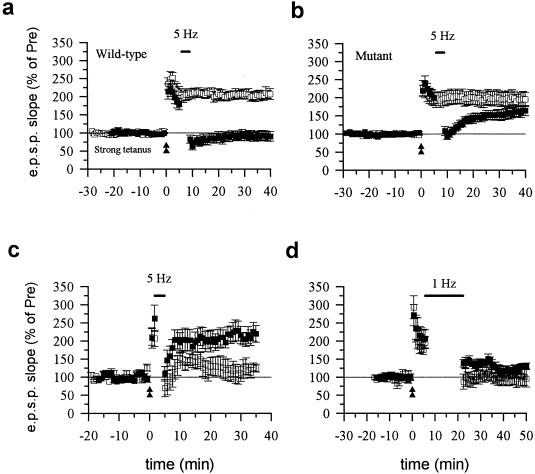Figure 3.
Depotentiation is abolished in calcineurin Aα mutant mice. (a) Theta frequency stimulation induced depotentiation in wild-type mice. Strong tetanic stimulation (100 Hz, twice for 1 sec with a 20-sec interval) produced long-lasting enhancement of synaptic response (open squares). Five-hertz stimulation (3 min) induced long-lasting depression when delivered 5 min after the induction of LTP (filled squares, 91.4 ± 12.9%, n = 14 slices/10 mice, t = 5.57, P < 0.01 comparing the potential 25 to 30 min after tetanus with normal LTP without 5 Hz stimulation). (b) Theta frequency stimulation did not induce depotentiation in calcineurin Aα mutant mice. Strong tetanic stimulation produced similar long-lasting enhancement of synaptic responses (open squares) as in wild-type mice. However, 5-Hz stimulation only produced a brief depression, but the field EPSP returned to the potentiated level 30 min later (filled squares, 162.5 ± 14.1%, n = 13 slices/7 mice, not significantly different comparing with LTP without 5-Hz stimulation in slices of mutant mice). (c) Theta frequency stimulation delivered 1 min after LTP induction induced depotentiation in wild-type mice (open squares, 122.9 ± 15.1%, n = 5 slices/5 mice) but not mutant mice (filled squares, 213.6 ± 20.5%, n = 7 slices/5 mice, t = 3.28, P < 0.005 comparing the potential 25 to 30 min after theta frequency stimulation between wild-type and mutant mice). (d) Low-frequency stimulation (1 Hz, 15 min) induced similar LTD in mutant (filled squares, 130.3 ± 6.3%, n = 6 slices/6 mice) and wild-type (open squares, 103.5 ± 23.3%, n = 6 slices/5 mice, t = 1.45, not significantly different comparing the potential 25 to 30 min after low-frequency stimulation between wild-type and mutant mice) mice when delivered at 5 min after the induction of LTP.

